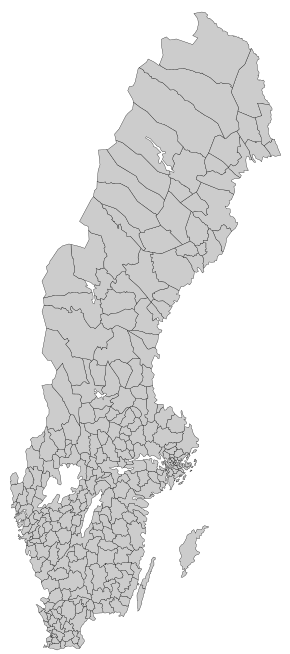Municipalities of Sweden facts for kids
Quick facts for kids Municipalities of SwedenSveriges kommuner (Swedish) |
|
|---|---|

Sweden's municipal borders
|
|
| Category | Municipality |
| Location | Sweden |
| Found in | Counties |
| Number | 290 (list) |
| Possible types | Municipality |
| Government | municipal assembly |
The municipalities of Sweden (Swedish: Sveriges kommuner) are like local governments for different areas in Sweden. There are 290 municipalities. They are in charge of many local services. These include schools, emergency services, and planning how towns grow.
Contents
How Swedish Municipalities Work
The Local Government Act of 1991 is a law that explains what municipalities should do. It also sets rules for how local governments are run. For example, it explains how to elect the people who make decisions for the municipality.
Who Makes Decisions in a Municipality?
Each municipality has a group called the municipal assembly (Swedish: kommunfullmäktige). This group is like a local parliament. It has between 31 and 101 members. The number is always odd. These members are chosen in elections every four years. These elections happen at the same time as the national elections.
The assembly then chooses a smaller group called the municipal executive committee (Swedish: kommunstyrelse). This committee helps manage the municipality's daily work. The person in charge of this committee is called the chairman. Many municipalities also have politicians called Municipal Commissioners (Swedish: kommunalråd). One of them is usually the chairman of the executive committee.
If a citizen thinks a local government decision is wrong, they can ask a court to check if it followed the law. This process is called a "legality trial."
The way Stockholm municipality is run is a bit different. It has its own special law for its government.
A Brief History of Municipalities in Sweden
The first laws for local government in Sweden started on January 1, 1863. There were about 2,500 local areas back then. Some were for cities and some for the countryside.
Changes Over Time
- 1863: The first local government laws began. There were about 2,500 municipalities.
- 1952: Sweden decided to make municipalities larger. The number of rural municipalities went down a lot, from 2,281 to 816. Cities were not changed much at this time.
- 1971: It was decided that the 1952 changes were not enough. A new plan was made to create even larger municipalities. These new areas were called "unitary municipalities" (kommun). The number of municipalities dropped to 464.
- 1974: The number went down even more, to 278.
- Today: The number of municipalities has gone up a little since then. Now, there are 290 municipalities in Sweden.
If a new municipality is to be created, the central Swedish government decides. It is suggested that a new municipality should have at least 5,000 people living in it.
What Does "City" Mean in Sweden?
Some municipalities, like Stockholm, Gothenburg, and Malmö, still use the word "City" (Swedish: stad) when they talk about themselves. This is just an unofficial choice. It does not change how they are run. This can sometimes be confusing because stad usually means a large built-up area, not an administrative area.
Where Are Swedish Municipalities Located?
Swedish municipalities cover the entire country. There are no areas in Sweden that are not part of a municipality. This is different from some other countries, like the United States.
Large Northern Municipalities
The municipalities in northern Sweden are very large. They cover huge areas of land where not many people live. For example, Kiruna municipality is sometimes said to be one of the world's largest "cities" by area. It is 19,446 square kilometers! To compare, the entire country of Lebanon is about 10,452 square kilometers. This means some northern municipalities are bigger than many counties in the more crowded southern part of Sweden.
How Municipalities Are Divided Internally
Before 2016, municipalities were divided into "parishes" (församlingar). These were linked to the Church of Sweden. Now, they are divided into "districts." These districts are mostly the same as the old parishes were in 1999.
What Do Municipalities Do?
By law, municipalities are responsible for many important services for their residents:
- Childcare: This includes care for young children and pre-school programs.
- Schools: They run both primary (elementary) and secondary (high) schools.
- Social Services: They provide help and support to people in need.
- Elderly Care: They offer services and support for older people.
- Support for People with Disabilities: They help people with disabilities.
- Health and Environment: They look after public health and environmental issues in their area.
- Emergency Services: They provide fire and rescue services. (The police are run by the central government, not municipalities.)
- Urban Planning: They plan how towns and cities will grow and develop.
- Sanitation: They manage waste collection and sewage treatment.
Many municipalities also offer other services. These can include fun activities for young people or housing services. They do this to make their area a good place to live.
 In Spanish: Anexo:Municipios de Suecia para niños
In Spanish: Anexo:Municipios de Suecia para niños

